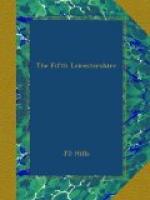There was one remarkable feature of the whole of this period of the war which cannot be passed over, and that was the very decided superiority of our Flying Corps. During the whole of our three months in the Kemmel area we never once saw a German aeroplane cross our lines without being instantly attacked, and on one occasion we watched a most exciting battle between two planes, which ended in the German falling in flames into Messines, at which we cheered, and the Boche shelled us. Towards the end of the war the air was often thick with aeroplanes of all nationalities and descriptions, but in those days, before bombing flights and battle squadrons had appeared, it was seldom one saw as many as eight planes in the air at a time, and tactical formations either for reconnaissance or attack seemed to be unknown; it was all “one man” work, and each one man worked well.
On the night of the 16th June the Battalion came out of trenches and marched to the Locre huts for the last time, looking forward to a few days’ rest in good weather before moving to the Salient, which we were told was shortly to be our fate. We had been very fortunate in keeping these huts as our rest billets throughout our stay in the sector, for though a wooden floor is not so comfortable as a bed in a billet, the camp was well sited and very convenient. The Stores and Transport were lodged only a few yards away at Locrehof Farm, and Captain Worley used to have everything ready for us when we came out of the line. During the long march back from trenches, we could always look forward to hot drinks and big fires waiting for us at the huts, while there was no more inspiring sight for the officers than Mess Colour-Sergeant J. Collins’ cheery smile, as he stirred a cauldron of hot rum punch. Bailleul was only two miles away, and officers and men used often to ride or walk into the town to call on “Tina,” buy lace, or have hot baths (a great luxury) at the Lunatic Asylum. Dividing our time between this and cricket, for which there was plenty of room around the huts, we generally managed to pass a very pleasant four or six days’ rest.
CHAPTER III.
“The salient.”
22nd June, 1915. 1st Oct., 1915.
On the 22nd June, 1915, after resting for five days in the Huts, where General Ferguson, our Corps Commander, came to say good-bye, we marched at 9.0 p.m. to Ouderdom, while our place in the line was taken by the 50th Northumbrian Territorial Division, who had been very badly hammered, and were being sent for a rest to a quiet sector. At Ouderdom, which we reached about midnight, we discovered that our billets consisted of a farm house and a large field, not very cheering to those who had expected a village, or at least huts, but better than one or two units who had fields only, without the farm. It was our first experience in bivouacs, but fortunately a fine night, so we soon




